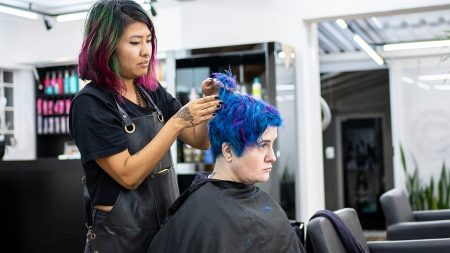Small loans are increasingly popular with small businesses, according to data from the Federal Reserve’s latest Small Business Credit survey.
While the average SBA loan size in 2024 was $443,097, more businesses are seeking financing in the total of $100K, $50K and even $25K as they seek to sustainably scale, manage rising operating costs and manage increased borrowing costs.
While it may make sense that smaller businesses are seeking lower loan amounts, borrowing small doesn’t always translate to easy access to financing. Businesses can face barriers to smaller financing – and for some, seeking small loans themselves can be an obstacle to growth. Here’s Bankrate’s take on the data.
Key takeaways for small business loan sizes
- Business loans under $25K are the most popular loan size. Smaller loans can help newer business owners incrementally scale, as well as reduce their borrowing costs and improve their eligibility.
- Business loans are getting smaller. The average SBA loan amount has decreased by 38 percent in the past four years, from $704,581 in 2021 to $435,827 in 2025.
- Lower-revenue businesses tend to seek smaller loans. Loans under $25k were more popular for businesses making under $100,000 in annual revenue, with 42 percent of businesses making between $25,001 to $50,000 per year seeking smaller loan sizes.
- Female-owned businesses overwhelmingly seek smaller loans. Over one third (35 percent) of female-owned businesses sought financing of $25K or less, compared to 19 percent of male-owned businesses and 24 percent of equally-owned businesses.
- Access to smaller loans can be a barrier to entry. Low time in business, a limited credit history or smaller revenues can bar businesses from accessing smaller loans, even for those that need smaller loans the most.
Small business, small loans
In the Federal Reserve’s 2024 Small Business Credit Survey, the most popular loan amount sought by small businesses over the previous 12 months was $25,000 or less.
According to the survey:
- 23 percent of small businesses sought financing for $25k or less
- 17 percent sought financing between $25,001 and $50,000
- 20 percent sought financing between $50,001 and $100,000
- 18 percent sought financing between $100,001 and $250,000
- 15 percent sought financing between $250,001 and $1 million
- 7 percent sought financing over $1 million
Small businesses can seek smaller loans for a variety of reasons. Smaller loans mean lower risks for small businesses, especially if a business owner chooses to incrementally scale their business, or uses
Interest rates are another factor in the size of loans businesses are seeking smaller loans.
“Because the interest rates have not come down as far as many in the industry expected by now, it led to some small businesses simply having to accept that the rate environment was going to be higher for longer and go ahead with a loan application,” says Mary Miklethun, senior vice president and product lead for business deposits and lending at US Bank.
As the Federal Reserve has been slow to shift the prime interest rate from their sky-high rates, the average loan size has decreased. The higher the rate, the more it costs to borrow, which can cap how large of a loan borrowers qualify for with their revenue and credit.
In 2021, when the prime rate stayed at 3.25 throughout the year, the average SBA loan was $704,581. As rates rose, borrowers balked, leading to the average SBA loan for 2025 currently sitting at $435,827 – a 38 percent decrease over four years.
Lower-revenue firms seek smaller loans
Businesses with lower annual revenues tend to seek financing in smaller amounts, possibly in line with how much financing they can afford, and proportional to their operating expenses growth trajectory.
According to the 2024 Small Business Credit Survey:
- 35 percent of businesses making $25k or less per year sought financing under $25k or less.
- 42 percent of businesses making $25,001 to $50,000 per year sought financing under $25k or less.
- 39 percent of businesses making $50,001 to $100,000 per year sought financing under $25k or less.
- 32 percent of businesses making $100,001 to $250,000 per year sought financing under $25k or less.
- 25 percent of businesses making $250,001 to $1 million per year sought financing under $25k or less.
- 19 percent of businesses making $500,001 to $1 million per year ought financing under $25k or less.
- 13 percent of businesses making $1 to $5 million per year sought financing under $25k or less.
- 5 percent of businesses making $5 to $10 million per year sought financing under $25k or less.
- 5 percent of businesses making over $10 million per year sought financing under $25k or less.
Smaller businesses seeking smaller loans makes sense from a scale standpoint.
In the same survey, over half (56 percent) of small business owners sought financing to meet operational expenses, which can encompass expenses such as payroll, utilities, building or equipment leases and other day-to-day expenses. Business owners with smaller revenue amounts may have lower operating expenses, or seek loans proportional to how much their business makes.
Loans under $25,000 sought overwhelmingly by female business owners
Female entrepreneurs in particular tend to seek financing on a smaller scale.
According to the 2024 Small Business Credit Survey:
- 35 percent of female-owned businesses sought financing of $25K or less, compared to 19 percent of male-owned businesses and 24 percent of equally-owned businesses.
- 16 percent of female-owned businesses sought financing between $25,001 and $50,000, compared to 17 percent of male-owned businesses and 21 percent of equally-owned businesses.
- 20 percent of female-owned businesses sought financing between $25,001 and $50,000, compared to 20 percent of male-owned businesses and 19 percent of equally-owned businesses.
- 16 percent of female-owned businesses sought financing between $50,001 and $100,000, compared to 18 percent of male-owned businesses and 21 percent of equally-owned businesses.
- 11 percent of female-owned businesses sought financing between $100,001 and $250,000, compared to 18 percent of male-owned businesses and 13 percent of equally-owned businesses.
- 2 percent of female-owned businesses sought financing over $1 million, compared to 9 percent of male-owned businesses and 2 percent of equally-owned businesses.
Female business owners have a few reasons that may be behind wanting to seek financing in smaller amounts. According to the same survey, over one in three (36 percent) of female-owned businesses made less than $25,000 per year in revenue. This may limit how much female business owners will want to borrow in proportion with how much their business makes.
Many female business owners also prefer to start small with their business and scale up over time, often starting with their own personal capital and slowly increasing how much they borrow in order to scale sustainably.
When Anandita Yadav, owner and founder of cotton clothing company Zillajee, started, put her own personal capital on the line in order to launch her product line.
“I didn’t want to take a loan initially,” Yadav said. “So that’s why I started with $500, and since then my business has grown profitably. Whatever profits I’ve earned, I’ve put them back into the business.”
Smaller loans can be a barrier to access
While smaller loans can be a way for businesses to obtain financing in a more gradual fashion, they aren’t always accessible.
For owners just starting out, going into debt can prove to be riskier than entrepreneurs are comfortable with – especially when startup loans can be competitive. Newer businesses also tend to be seen as riskier to lenders.
“Most lenders will expect the business to have established some amount of time before extending credit,” Miklethun says. “It’s all about how you assess risk and smaller loan sizes are typically going to correlate with businesses that have less history and less to go on in terms of their ability to repay.”
Many traditional lenders are geared toward larger loan amounts, with some offering products whose minimums begin in the tens of thousands of dollars.
When Yadav wanted to start scaling up her business to purchase more inventory and push new products, she had a difficult time finding a loan that had an annual revenue she could meet.
“All the stuff that I read online that has to do with funding or investing in a business is focused more on medium and large businesses,” Yadav said.
Without access to smaller loans, small businesses may have trouble scaling their business, paying their operating expenses, weathering a slow season or handling an emergency expense. However, there are still ways small businesses can access loans in smaller amounts.
How to find a smaller business loan
If you’re looking for a business loan on the smaller side, you have a few options.
Business credit cards
Business credit cards can provide more flexible funding options for smaller borrowing amounts, with added perks such as the opportunity to earn rewards on the money you spend. Business credit cards also tend to have more relaxed revenue and time-in-business requirements than traditional loans.
When considering a business credit card, there are a few things to keep in mind. Many business credit cards come with an annual fee. Qualifying for a business credit card will require a credit check, which can limit options for borrowers with poor or limited credit history. As well, business credit card rates tend to
Business lines of credit
A business line of credit works similarly to a business credit card, with a few key differences. Lines of credit often have higher limits and don’t always come with annual fees, and may have lower interest rates than credit cards.
Like a credit card, a line of credit allows you to draw as much or as little as you need throughout the draw period. A line of credit may be easier to qualify for than a traditional loan, and allow you to borrow smaller amounts. However, business lines of credit do often require a certain revenue minimum, time in business and credit score. A line of credit may also require you to secure the loan with collateral or a personal guarantee.
SBA microloans
Certain Small Business Administration (SBA) loans are targeted toward business owners seeking smaller loan amounts known as microloans. SBA microloans are guaranteed by the government, offering funds up to $50,000 to qualifying borrowers. They have more relaxed requirements than other types of SBA loans, and come with rate caps that help to keep borrowing costs down.
SBA microloans do require either collateral or a personal guarantee. They also have a more limited pool of lenders, as they’re offered by non-profit institutions instead of traditional lenders. While they can have lower borrowing costs and relaxed credit requirements, they may also be harder to qualify for, require more documentation and have a longer waiting period.
Opportunity loan programs
If you’re part of an underserved community, then you may qualify for an opportunity loan program. These programs offer funding with more relaxed requirements, lower interest rates and reduced borrowing costs to borrowers who may otherwise struggle to access capital.
“There are classes in the economy who haven’t had the same economic opportunity and are starting smaller,” Miklethun says. “We have a program called the Business Diversity Lending program which is available to women owned, veteran owned and minority-owned businesses, and it offers somewhat modified credit criteria with the intent of addressing historically economically disadvantaged classes.”
Talk to your lender to see if there are such options available, or seek out lending programs in your area that specialize in opportunity funding.
The bottom line
Access to smaller business loans is vital to the small business owners of America. While loans under $25,000 are popular among entrepreneurs, especially as a way to save on borrowing costs and to reduce the risk of default, access to these types of loans can prove difficult for newer businesses or those with limited revenue and credit history. This can prove to be a barrier to access for businesses who are especially reliant on smaller loans, like female-owned businesses.
Entrepreneurs seeking smaller business loans may be able to access funding in the form of credit cards, lines of credit, SBA microloans or opportunity funding programs.
Read the full article here









